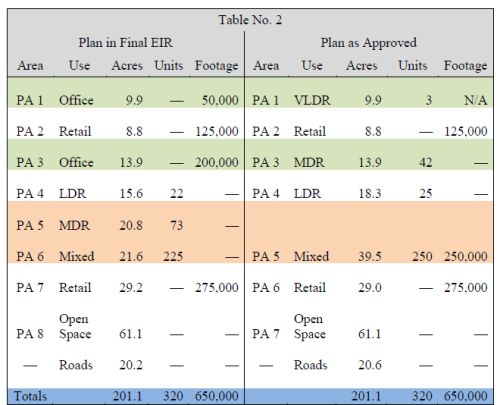Chelsea Maclean is a partner in Holland & Knight's San Francisco office
HIGHLIGHTS:
- California's Fourth District Court of Appeal has provided useful guidance on processing requirements for environmental review documents prepared under the California Environmental Quality Act (CEQA) when project modifications are required by decision-makers after a final Environmental Impact Report (EIR) has been published.
- In Residents Against Specific Plan 380 v. County of Riverside, the court held that CEQA's informational requirements had been satisfied because the project modifications would not result in any new significant impacts or substantially more severe impacts as compared to those identified in the draft and final EIRs.
- After the appellant sought a writ of mandate in the trial court asserting that the County failed to comply with procedural, informational and substantive provisions of CEQA, the trial court denied the petition in its entirety and entered judgment in favor of the County and the applicant. The appellate court affirmed on all claims.
In Residents Against Specific Plan 380 v. County of Riverside, California's Fourth District Court of Appeal provides useful guidance on processing requirements for environmental review documents prepared under the California Environmental Quality Act (CEQA) when project modifications are required by decision-makers – in this case, the Riverside County Planning Commission and Board of Supervisors – after a final Environmental Impact Report (EIR) has been published.
The court, in an opinion published on March 15, 2017, soundly rejected all of the appellant's claims and held that CEQA's informational requirements had been satisfied because the project modifications would not result in any new significant impacts or substantially more severe impacts as compared to those identified in the draft and final EIRs.
Case Background
The project at issue involved a general plan amendment, a change of zone and a specific plan adoption proposed by the Hanna Marital Trust (applicant) in the County of Riverside (County). On July 28, 2011, the County announced the release of a draft EIR analyzing 320 residential units and 650,000 square feet of office and retail use allocated between eight separate planning areas. After release of the draft EIR for public review and then preparation of a final EIR in response to public comments, the project was modified at both the Planning Commission and Board of Supervisors hearings. At the Planning Commission hearing, four planning areas were modified and the scale of the development was reduced. (Because the project involved a general plan amendment, California's Housing Accountability Act did not restrict the County's ability to reduce the size of the project.) At the Board of Supervisors hearing, the project was further modified to increase the overall scale of development back up to the totals analyzed in the final EIR but also shift development within planning areas by moving denser development away from neighboring low-density residential areas into the center of the project site.
At both stages, the County's environmental consulting firm analyzed the project modifications and concluded that the modifications would not create new significant environmental impacts or substantially increase the severity of impacts and that the final EIR did not need to be recirculated to the public. Specifically, the environmental consulting firm's conclusion that the Planning Commission's project modifications would not result in any new significant impacts rested on the fact that the scale of development had been reduced. The consulting firm's conclusions that the Board of Supervisor's project modifications would not result in new significant impacts relied on fact that denser development had been relocated to the center of the site, thereby reducing impacts to the surrounding, existing uses.
The table below demonstrates how the project was analyzed in the final EIR compared to the project that was ultimately approved by the Board of Supervisors; the final development totals remained unchanged, but the allocation and arrangement of uses within the planning areas were substantially reconfigured.

Source: California Fourth District Court of Appeal
On Dec. 18, 2012, the Board of Supervisors voted to certify the final EIR and tentatively approve the general plan amendment, zone change and specific plan adoption. The County planning staff and applicant then spent several months modifying the approval documents to reflect the project modifications. On Nov. 5, 2013, the Board of Supervisors issued final approvals.
After the appellant sought a writ of mandate in the trial court asserting that the County failed to comply with procedural, informational and substantive provisions of CEQA, the trial court denied the petition in its entirety and entered judgment in favor of the County and the applicant. The appellate court affirmed on all claims.
Court Rejects Appellant's Procedural Arguments
The court rejected all of appellant's procedural claims, including the claims that the County substantially modified the project after approving it; approved the project without concurrently adopting findings, a statement of overriding considerations and a mitigation plan; and failed to recirculate the final EIR after modifying the project.
Most notably, the court's holding that the County did not need to recirculate the final EIR after modifying the project confirms a decision-maker's ability to make project modifications after a final EIR has been published. Specifically, the appellant argued that the project modifications would increase certain impacts. In each instance, the court held that recirculation was not necessary pursuant to Public Resources Code Section 21092.1 based on the County environmental consulting firm's analysis that the project modifications would not result in any significant new or substantially more severe impacts.
For example, the appellant argued that changing the designation in one planning area from medium density residential to mixed use would increase traffic impacts and change traffic patterns. The court was satisfied with the County environmental consulting firm's conclusion that because the total number of residential units and amount of commercial development did not change from that analyzed in the final EIR, no additional traffic impacts were expected. Additionally, the appellant argued that moving the mixed use designation next to a conservation area would create additional biological impacts. Again, the court was satisfied by the consulting firm's analysis – in this case, supported by the rationale that since the final EIR had considered impacts related to conservation area adjacency in connection with a different mixed use planning area and given that mitigation measures would address conservation area adjacency issues.
Further, while the Notice of Determination contained erroneous information – it incorporated elements of the project description as it existed after the Planning Commission hearing in October 2012 and not the project as it was approved by the Board of Supervisors in November 2013 – the court concluded that the errors did not justify unwinding the County's approval of the project. The court found that the Notice of Determination still complied with the informational requirements of CEQA. Moreover, the appellant filed its petition for writ of mandate during the 30-day statute of limitations established by the Notice of Determination, so any remedy to extend the statute of limitations would have provided no relief to the appellant.
Court Upholds County's Rejection of Suggested Mitigation Measures
Finally, the court held that the County adequately considered specific suggestions for mitigating the significant and unavoidable air quality and noise impacts. During the public comment period, certain air quality mitigation measures were suggested by the South Coast Air Quality Management District (SCAQMD) and the neighboring city of Temecula. Specifically, the SCAQMD suggested use of more stringent construction equipment in order to reduce air quality emissions. The court found that the County's rejection of the SCAQMD measure, based on the rationale that the proposed equipment meeting higher emissions standards would not be available at the time of construction, was sufficiently detailed to support its rejection of the measure. The court also upheld the County's rejection of the City of Temecula's suggestion to comply with certain energy code requirements in favor of a performance standard, which would give the applicant flexibility and would reduce enforcement problems with the more prescriptive measure. Finally, the court held that the County did not abuse its discretion by failing to adopt, or even respond to, measures suggested by the appellant to reduce air quality and noise impacts. The appellant's suggestions were submitted the day before the Board of Supervisors' hearing and, as the court noted, more than 14 months after the close of the public comment period.
Conclusion
Ultimately, this case presents useful guidance on how CEQA's informational directive, allowing for ample public review and comment, can be balanced with engaged decision-making bodies that aim to modify and refine a development project up until the final hearing and even after a final EIR has been published.
The content of this article is intended to provide a general guide to the subject matter. Specialist advice should be sought about your specific circumstances.
